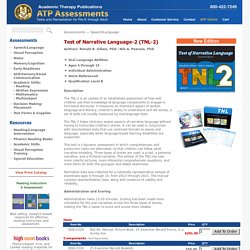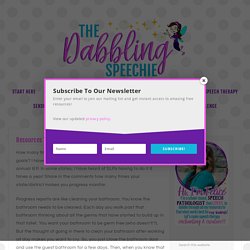

Pragmatics. ATP: Test of Narrative Language-2 (TNL-2) Authors: Ronald B.

Gillam, PhD / Nils A. Pearson, PhD Oral Language AbilitiesAges 4 through 15Individual AdministrationNorm-ReferencedQualification Level B Description The TNL-2 is an update of an established assessment of how well children use their knowledge of language components to engage in functional discourse. The TNL-2 helps clinicians assess aspects of narrative language without having to transcribe children's stories.
This test is a dynamic assessment in which comprehension and production tasks are alternated, so that children can follow adult narrative modeling. Normative data was collected for a nationally representative sample of examinees ages 4 through 15, from 2013 through 2015. Administration and Scoring Administration takes 15-20 minutes. 6) Progress Monitoring SF 2 16 12. Emerging Literacy & Language Assessment. The Emerging Literacy & Language Assessment (ELLA), evaluates the skills children ages 4;6 to 9;11 need to become proficient readers.

The ELLA meets Early Reading First requirements for educators needing to use evidence-based diagnostic tools to identify children at risk for reading failure. The manual includes a Curriculum and Classroom Connection for each of the 22 subtests and case studies to help you establish treatment and IEP goals. Individual administration for ages 4;6 – 5;5 (all three sections) takes approximately 30-45 minutes, and for ages 5;6 – 9;11 (all three sections) takes approximately 60 minutes. The ELLA is norm- and criterion-referenced.
It includes standard scores, confidence intervals, percentile ranks, means, and age equivalents. Section 2 – Sign and Symbol Recognition and Interpretation assesses environmental symbol identification, letter-symbol identification, word reference association, and reading comprehension for one to three sentences. Why Test With the ELLA? MISL Rubric (2) PhonologicalandPhonemicAwareness. How to use CCC-2 - Pearson Assessment Support. Step 1: Complete identifying information On the Raw Data tab, enter the child's first and last name.

(This information must be entered to identify the child's case.) Enter the child's sex. (This information is optional.) Enter the name of the person completing the rating scale. Step 2: Record the Item Scores Enter the raw scores from each of the test items. Step 3: Convert Raw Scores to Scaled Scores, Composite Scores, and Percentile Ranks Select on a child's name to convert his or her raw scores. Step 4: Print and Save the Scoring Summary Select the child's name and click the ""Create Summary Chart"" button. If you copy the CCC-2 scoring spreadsheet, be aware that the workbook includes macros as well as a hidden worksheet that is used in the summary macro for computation of percentile ranks.
Hiding Game (spatial vocab) Resources To Help You Progress Monitor Speech Goals - thedabblingspeechie. How many times a year do you progress monitor speech goals?

I have to do it 3 times in California and then for the annual IEP. In some states, I have heard of SLPs having to do it 8 times a year! Share in the comments how many times your state/district makes you progress monitor. Progress reports are like cleaning your bathroom. You know the bathroom needs to be cleaned. Who doesn’t want a squeaky clean bathroom all the time!? Maybe it is my caseload of 55 students that makes it such an unwanted task? Progress Monitor Speech Goals With A Checklist (save your sanity) To stay organized and make sure I don’t miss a step in the process, I made a progress monitoring checklist. Tips On How To Progress Monitor Speech Goals Efficiently I have come to accept that progress reports are not going away.
A Dynamic Assessment for Social Communication Disorders. The Early Functional Communication Profile assesses pivotal preverbal communication skills that children need to develop functional communication.

This measure is sensitive to small, subtle changes in joint attention, social interaction, and communicative intent and is appropriate for students with moderate to severe disabilities (autism spectrum disorders, cognitive impairments, coexisting disorders, and augmentative/alternative communication systems). The Early Functional Communication Profile assessment uses a hierarchy of prompts to provide information about the skills the child performs with some degree of adult assistance including information about developmental level, level of environmental prompt, and level of adult-action prompt. Use the Early Functional Communication Profile to determine a starting point in therapy and to show progress over time.
The Early Functional Communication Profile subtests: Statistics. Datarecordsheets. MISL 13A. PLS-5 Preschool Language Scales-5 Screening Test. A PLS-4/PLS-5 study was conducted in 2010 with 134 children from the PLS-5 standardization sample.

Each child’s PLS-5 Auditory Comprehension (AC), Expressive Communication (EC), and Total Language standard score was compared to the corresponding scores on PLS-4. On average, scores on the PLS-5 are 1 point lower on the AC scale, 1.5 points lower on the EC scale, and 1 point lower on the Total Language score in this study. We realize that if a child receives PLS-5 standard scores that are even one point higher than PLS-4 standard scores that were borderline (e.g., 77), the child may no longer meet the district criteria for eligibility for services. As you will find in the PLS-5 Examiner’s Manual on page 16: You pointed out that you are working with districts with rigid eligibility cut offs—apparently that means the district does not take other test results (e.g., language sampling, observations in the classroom, teacher interviews) or the standard score confidence bands into account.
Wiig Criterion Referenced Inventory of Language.